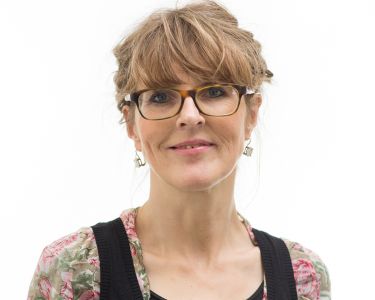
Climate and Culture united in crisis – or in the Next Renaissance?
Director of Julie´s Bicycle, London
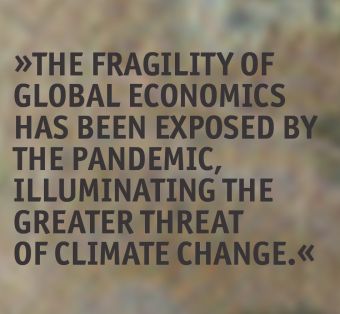
Climate and Culture united in crisis – or in the Next Renaissance?
The Green and The Game changer
The COP26 global climate talks failed to commit to global temperature limits of 1.5 degrees warming, or to establish financial mechanisms to ensure climate justice is given the attention it richly deserves. Global climate governance has not yet succeeded in building consensus for rapid action in spite of the Paris Agreement.7 Perhaps the real challenge is found in root metaphors and their narratives—nature as machine, hostile, to extract, improve, sell, or sentimentalise. The story of climate change is in the buried histories of human and nature conquest, anchored in cultural values of human supremacy. The climate crisis as a cultural crisis, the consequence of myths and stories that permeate society in profoundly subtle ways.
The fragility of global economics has been exposed by the pandemic, illuminating the greater threat of climate change. Ambition to take action has surged across communities and business—the sheer volume of net zero commitments has potential to profoundly change our world —though only if the pendulum swings away from offsetting to absolute greenhouse gas reductions, especially in wealthy economies. And COP26 has bolstered net-zero targets by tightening governance for
carbon trading rules. Up until now cultural policy has, by and large, been oblivious to the encroaching climate crisis, rarely invoking ‘externalities’ from nature (i.e. clean air, green space, carbon profiles), or cultural rights, safety and social inclusion, profoundly affected by environmental conditions. This is true at every level, though city policy is more progressive than national policy, as are smaller institutional commitments. New ambition in the cultural sector is creating conditions for good climate governance.
The arts, like any other sector, have an ecological footprint and Julie’s Bicycle (JB), founded in 2007, began with a focus on the sector’s impacts, and ways to work within the ecological constraints of our planet. Unleashing the energy of the creative community and championing values that restore our sense of belonging within nature, was the real objective. Beyond the arts, the potential of the
creative industries to influence change—design, advertising, film, media, fashion—is huge. JB, which specialises in the arts, has translated the climate crisis into everyday currency with sector-specific expertise and resources that inspire words and action. Our premise is that doing empowers the arts to champion ambitious climate action across civil society. Working closely with the UK music industry, JB generated a methodology for greenhouse gas emissions analysis, carbon calculators for creative activities (buildings, tours, festivals, productions) that are used across the globe (5,000 current users of which about 2,000 are international).
Over the last decade, Julie’s Bicycle has expanded into performing and visual arts and museums, blending cultural and scientific knowledge for cultural practice to serve the planet.
Culture as an ecosystem: Arts Council England
Culture, just like any other sector, is an ecosystem: changes to one part are felt by all. Climate action needs to be tackled eco-systemically, including changes to policy and investment to align international frameworks. These goals are clear: net-zero carbon, green economy and climate justice. In 2012, Arts Council England (distributing £507million in 2019/20) embarked on the largest environmental literacy programme for culture anywhere in the world, making environmental requirements a funding condition. The backdrop was a bigger policy moment: the 2008 UK Climate Change Act. All Arts Council’s National Portfolio organisations (some 828 receiving core funds over multiple years) were asked to measure environmental impacts using JB’s Creative Green tools and have a policy and action plan. The data collection and policies formed a small part of a rich programme of research, resource development and knowledge-sharing evaluated annually. JB was initially
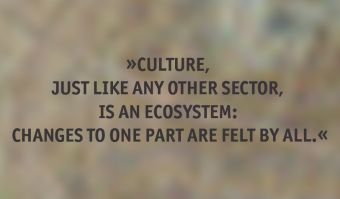
contracted for three years; by the time we complete the current contract (2023) the programme will be over a decade old. Results show an annual 4.5% reduction in energy use across 1,200 organisations, equivalent to over £16million in energy savings, with improved wellbeing and creative inspiration. Over time the partnership has got more demanding; 2018-2022 outputs include setting science-based targets for Arts Council’s largest energy users, 30 major institutions comprising 80 sites, which collectively reduced emissions by 18% in 2019-20.
A decade of data-gathering and collective cultural learning has generated credible and robust evidence, which makes a good case for scaling action. Starting from the basics—carbon footprints—the Arts Council’s deceptively simple policy is demonstrating how a sustainable cultural sector might work.
This vital perspective on culture, seen through the lens of our environment, has stimulated debate and passion, and catalysed a dialogue about the purpose of the arts more widely.
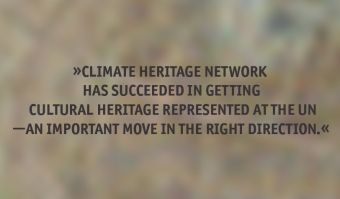
The International Perspective
Arts Council England’s intervention is only one, albeit effective, approach. Scotland and Wales, devolved nations with their own funding bodies, have established inspiring programmesthat combine accountability with exciting creative content. However, internationally, there is an urgent need to build environment into national arts policies. JB’s 2014 research partnership with the International Federation of Arts Council and Culture Agencies (IFACCA) recommended that national cultural policies explicitly reference environmental sustainability and build a global network to exchange ideas and resources with regional centres of excellence. The arts are hampered by a lack of data to underpin cultural policy, a gap which also prevents cultural activists from leading solutions and influencing major climate decision-makers. Climate Heritage Network has succeeded in getting cultural heritage represented at the UN—an important move in the right direction. In 2017, frustrated at the glacial pace of policy change, JB and World Cities Culture Forum, a network of global cities, developed a project for culture leads to connect to their environment counterparts in government and align goals. In many cities climate action is much more ambitious than national ambitions but there is patchy read-across of national cultural policies at this level, notwithstanding some inspirational examples.
Where are we now?
In the 6 months preceding COP 26 JB returned to national policy to understand progress aligning national culture policy with the Paris Agreement, as part of the British Council’s Climate Connection. Desk-based research, a survey to about 200 ministries, interviews and in-depth roundtables in Turkey, Indonesia, Nigeria, the UK, and Colombia, explored policy commitments and trends.We found that…
1. In spite of the Paris Agreement, requirements for climate action are still rare in national cultural policy. In the main, priorities are not yet reading explicitly across commitments to achieving global net-zero greenhouse gas emissions nor to environmental discourse on justice and just transition. There are some outstanding exceptions, notably Argentina where cultural policy reads explicitly across the national climate policy.
2. Many of the priorities of national cultural policies are environmental issues, especially relating to justice but framing and terminology does not, in the main, illuminate the commonalities. Cultural rights are often connected with environmental justice, and arts for transformation is connected with ‘just transition’. Translating cultural priorities into the vernacular of environmental policy and enriching environmental policy with cultural perspectives is a good starting point.
3. Broad sustainability issues are well represented in national cultural policy, especially as regards heritage, cultural rights and sustainable development. Connections to climate and environmental issues are often implicit. Policy dialogue with local and creative practitioners working from the ground up is urgently needed.
4. The huge potential of culture and creativity is not being leveraged systematically to address environmental issues in governance, i.e. to protect and preserve culture and heritage; to create safe places and strengthen and celebrate communities, circular design, new material use, innovative urban and city partnerships, new businesses, ideas and skills.
Art gives us different ways of knowing, and culture emerges from our many different ways of being; too often it feels like the creative community is showing up in spite of the lack of a presice place of action. While politics is debated in official halls, we work in the spaces between—sometimes being outside the system is exactly what’s needed. But what if we re-imagine a COP process shaped instead around culture?
The dominant cultural narratives must change and culture and creative endeavour should orient to this new purpose. The cultural sector—the arts, creative industries and heritage—can make a crucial
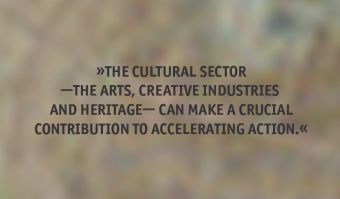
contribution to accelerating action. Culture is vital to national economies, contributing creative skills and innovation, and influencing lifestyles, tastes and consumption. But, most powerfully, art can change hearts and minds and it is intimately connected to place and to community. Artists can move us to reimagine our world and inspire societies to take climate action and contribute their best to the Next Renaissance.
Alison Tickell
Alison Tickell established Julie’s Bicycle in 2007 as a non-profit dedicated to mobilising action on the climate crisis, initially in the music industry and now across the arts internationally. Originally trained as a cellist, Alison worked with jazz improviser and teacher John Stevens, and community activist Dave O’Donnell at Community Music rethinking music education: what it’s for, what it values and who thrives, before setting up Julie’s Bicycle. She has also had many other roles (voluntary and paid).
Alison is an Ashoka Fellow.
Picture © James Allan
